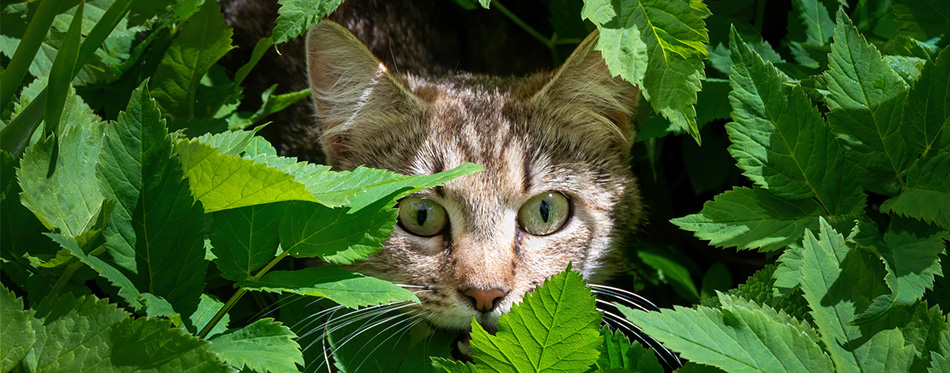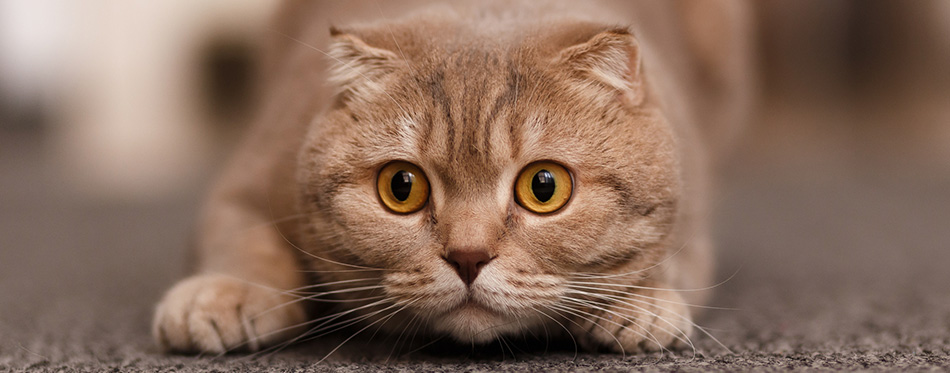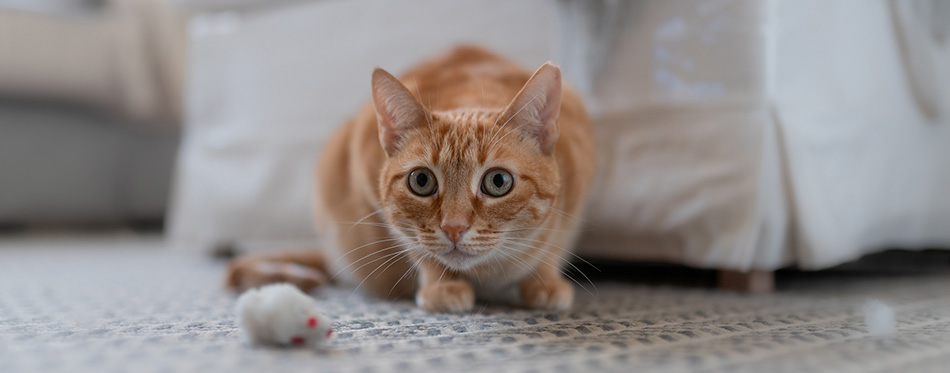The pupils are the literal “windows” to a living organism’s soul. And while we can argue about whether cats and dogs have a soul in the way we define the term, their pupils can tell us a lot of things that’s going on in their feline brains. Aside from the fact that pupils allow the entry of light into the cat’s retina, the different shapes that it undergoes can also convey a message. Here’s what your cat’s pupils are telling you, including changes in the shape of its eyes.

The Narrow Pupils of Arousal
One of the most striking differences between the pupils of humans and that of a cat is its shape. Whereas the human pupil takes on a rounded, near-perfect circular shape, the cat’s pupil has an elliptical form. It also comes in a vertical orientation. Hence, when the muscles of the iris contract, the feline pupils take the shape of a narrow slit. Most individuals describe it as a squint.
Regardless of how people call it, a narrow pupil allows less light to enter the eyes. In real-world situation, a narrow pupil allows the cat to focus on a particular object – a prey, for instance. It tries to minimize the amount of light entering the eyes by contracting the sphincter pupillae. This allows the cat to zero-in on an object of interest.
By the same token, seeing a cat with narrow pupils or squinted pupils often signify a high state of arousal. The term “arousal” here can mean a lot of things. For instance, it can mean agitation or restlessness. For some, it can be a sign that the feline is in a bad mood.
Hence, it is often not a good idea to approach a cat with narrow pupils. You will have to take it in the light of other manifestations that the cat may display. For example, letting out a loud hiss or showing its teeth often means that the animal is not in the mood for some cuddle time. The best activity for you and your pet is to engage it in a hunting game. This will help the animal dispense of its “edginess” and make it more amenable to petting afterwards.
The Wide Pupils of Excitement or Fear
The diametrical opposite of a narrow-shaped feline pupil, wide-open pupils often indicate excitement or fear. These are very powerful feline emotions that can spell either good or bad for the pet parent.
Pupillary dilation is always associated with the stimulation of the sympathetic nervous system. In case you’re wondering what this part of the nervous system does, it plays a role in stress responses. You may have heard of the substance we call epinephrine or adrenaline. It is this hormone that keeps you all pumped up.
One of the effects of adrenaline or epinephrine is to increase the size or diameter of the pupils. This allows the cat to take in more visual information from its surroundings. When it is on the hunt and still searching for prey, the prospect of having a sumptuous meal afterwards is enough to stimulate its sympathetic nervous system. This enlarges the diameter of its pupils so that it can scan its environment a lot better. Scanning helps the cat look for prey in a shorter amount of time.
However, one has to recognize that the cat also has to contend with prowling predators. This is part of its scanning behavior. As such, while it is searching for its next meal, the feline will also be on the alert for any sign of an approaching predator.
Hence, a wide-open pupil in cats can mean two things. It could be that the feline is feeling the excitement in the air or it is scared. If you are not sure which of these two feline emotions you are seeing in your cat, then you have to consider its body language. A scared cat will often make itself smaller by curling up into a ball.
The Unevenly-Sized Pupils
If you look at your cat’s eyes, you will see that the pupils are almost of the same size and shape. Hence, if the right pupil constricts, you can also expect the left pupil to turn narrow. However, if you see the pupils to be of different sizes – one is smaller or larger than the other – then it can only mean one thing. Your feline friend has “anisocoria”.
This pupillary response has nothing to do with the cat’s emotions or mood. Hence, do not ever think that your kitty is experiencing mixed emotions. Far from it. While there can be a difference in size between the two pupils, the variance is not that great as to be noticeable. However, if the size differential is too great not to notice, then it is often a sign of an eye problem.
If the anisocoria gets worse when the cat is in a low-light or darkened environment, the problem is often the pupil with a smaller size. In the dark, the natural response of the pupil is to increase its diameter to allow more light to enter the eyes. If the other pupil widens but the smaller one does not, it is because it is not receiving the right stimulus for it to dilate. This further increases the size differential between the two pupils.
On the other hand, if the anisocoria gets worse in bright environments, the problematic pupil is the larger of the two. In bright conditions, the pupil should be able to constrict or narrow itself down to regulate the amount of light entering. But since the larger pupil cannot accommodate, it also increases the difference in size with the other pupil.
There are different conditions that can bring about uneven pupils. These can include glaucoma, cancer, retinal diseases, congenital defects, and prior eye injury or trauma. Brain injury, optic nerve damage, eye inflammation, and spastic pupil syndrome can also contribute to the development of differently-sized cat pupils.
Check out our guide on the Best Vitamins For Cats for more info.

The Wide Open Eyes of Trust
After looking at the two fundamental shapes of the feline pupils and what they may convey, we can proceed with the changes in the shape of the cat’s eyes. The first one is wide-open eyes. When you see this in your cat, together with wide pupils, it often conveys trust. For some, it can also indicate a cat’s friendliness or calm demeanor.
Wide-open eyes occur because of the relaxation of the muscles surrounding the eyes. They are not in a contracted state, which can indicate a certain level of relaxation or calmness. In other words, the cat is not anxious or tensed. It is also not fearful, scared, or agitated. The absence of these “negative emotions” denote a feeling of happiness.
Try observing a cat that sits or lies on the lap of its owner. Both the eyes and the pupils are wide open. You will also notice that there is no tension in the body of the animal. You can feel the softness of the muscles underneath the skin. It is not tight or tense. Check its tail. It will often be in an upright position. The ears are also in the forward position. It may rub its body against your leg or snuggle up to a cat-friendly dog.
The point here is that the cat trusts you. It is often a good sign to initiate some bonding moments with your kitty. It will appreciate the time you’ll spend with it.
The Droopy or Sleepy-Looking Eyelid of Contentment
While a cat that shows wide open eyes conveys trust in its owner, a sleepy-looking cat can mean that the feline is very relaxed and happy.
Droopy eyes are often associated with relaxed muscles of the upper eyelids. They are not tensed or in a contracted state. This allows the eyelids to “fall” over the upper half of the cat’s eyeballs. In a way, it looks like a squinted eye. However, one has to take a look at the pupils of the cat as well. If it is wide open or in its normal size, then there is a good chance that your feline pet is content and happy.
There are additional signs that will help you decipher your cat’s mood in association with half-closed eyes. For example, if you notice that the feline’s ears are in a forward position, then you can think that the kitty is happy. You can also look at its tail. A happy and contented feline will hold its tail up high. It can also make very minute vibrations as if it is very happy to see you.
One of the best ways to determine if your pet feline is content or not is by looking at its stance. A happy feline will have a very relaxed stance. It will never curl up into a ball or make the hair on its back stand up. It may lay down on its back and present its belly to you, waiting for your touch. And if you look at its eyes, you will notice that it is half-closed. This is one of the surest signs that you have a friendly cat on hand.
The Narrow Pupil in a Squinted Eye
This is almost the same as having droopy eyes. However, if you take note of the pupils, they will be narrow or squinted. If you have this combination of squinted eyes and narrow pupils, you’d better stay back. This kitty is not in the mood for some cuddle time.
There is a reason why cats will have a slit-eyed look. It is a means of protection. In the presence of an opponent, they have to do everything they can to protect their eyes. Half-closing the eyes expose only a fraction of the cornea. In case their opponent attacks and tries to strike their eyes with its claws, it will be a lot easier and quicker for the cat to close its eyelids.
As mentioned, the narrowing of the pupils allows the cat to focus on something. When taken in the context of aggression, this means the feline has its “eyes” on its opponent. It is forever vigilant of the next move its enemy might take. When you combine these two – pupillary constriction and eye narrowing – you get a formidable defensive strategy.
Hence, it is never wise to approach a cat that’s giving you a slit-eyed look. This is especially true if its pupils are also constricted. It only means it considers you as a threat and will never hesitate to defend itself.
Related Post: Cat Calming Sprays

The Feline Unblinking Stare
We all adore Puss making that now-iconic wide-eyed look and quivering stare. For most folks, it is a sign of trust and friendliness. However, there is another kind of feline stare that can be quite disconcerting.
When a cat doesn’t break its stare, it often means the animal is exerting its dominance over you. It doesn’t recognize you as a trustworthy owner or it may be uncomfortable around you. Again, this has its roots in the predatory nature of cats. If they are on the hunt, they will always focus on their prey. Blinking can provide the opportunity for the prey to escape. In terms of aggression, a cat will never blink when facing a predator or an enemy. It doesn’t want to give its opponent that split-second chance to attack. Hence, it stares it without batting an eyelash.
Under no circumstances should you enter in a staring competition against your cat. This makes it more nervous. Doing so can also switch on the aggressive tendencies of the animal. Break the eye contact at once. Look away and pretend that you did not see the cat’s stare down. At least, the only thing you’ll nurse is a bruised ego instead of feline scratches and bites.
The feline eyes can tell us so much about its mood. Figuring out what the different shapes of its pupils are and the various “forms” of its eyes can help us determine how we should interact with our furry friends.
Source:
- How to Learn the Meaning of Cat Eyes’ & Know What Your Cat Is Thinking – Michelson Found Animals

